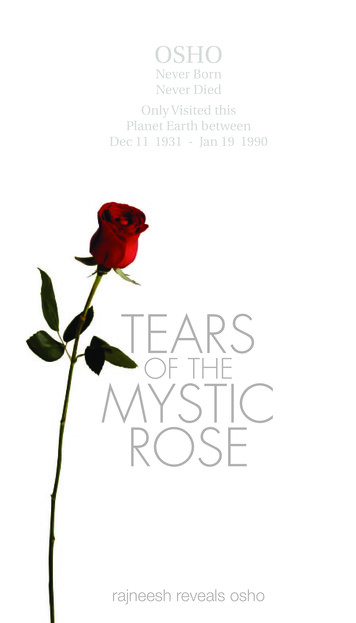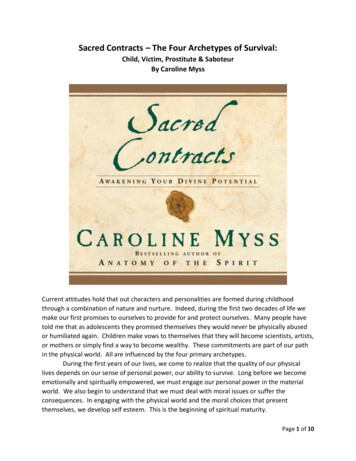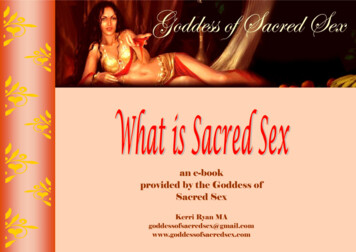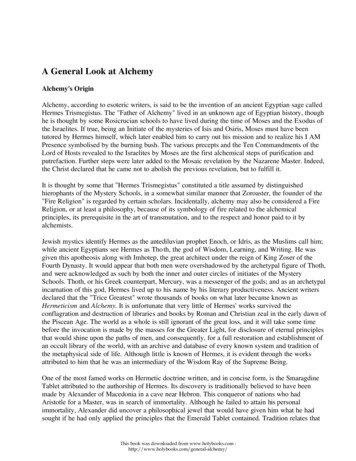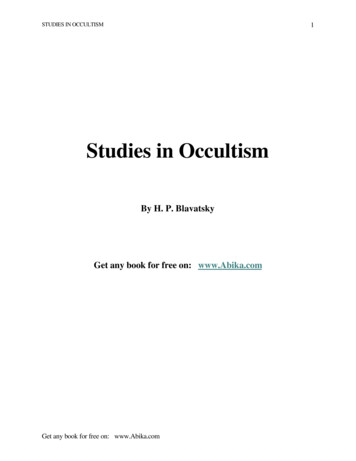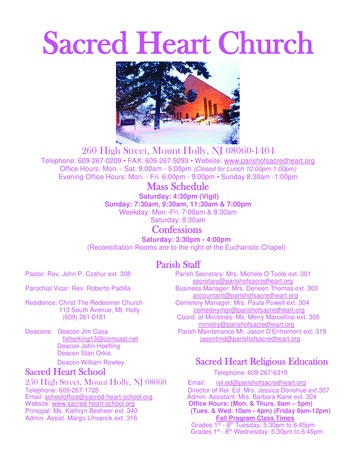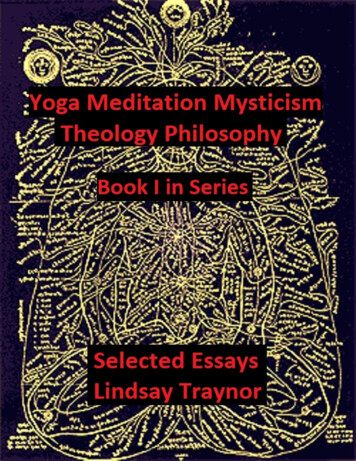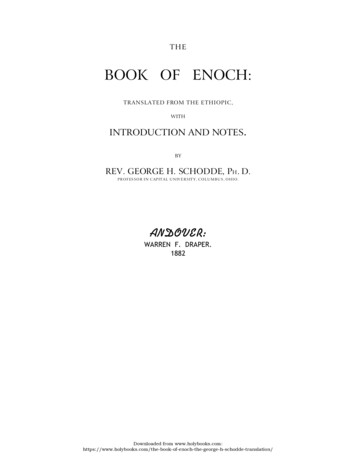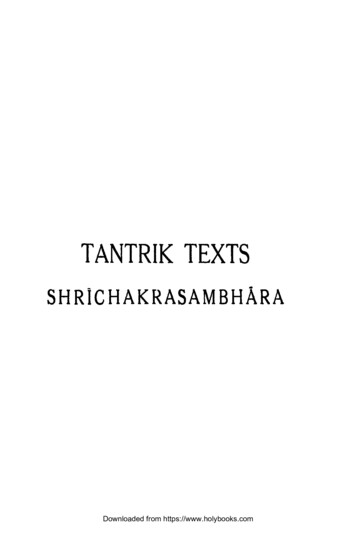
Transcription
ACKNOWLEDGMENTSThis book would not have been possible without the support, patience, and understandingof others. In particular, I greatly appreciate the support of my wife Risa, son Isaac, anddaughter Hannah, who have served as sounding boards for my ideas throughout manyyears of research. I also owe a great debt of thanks to John Anthony West, whose steadfastefforts—both on my behalf and on behalf of the larger community of researchers and writersof which I am a part—are greatly appreciated. I would like to thank Edmund Meltzer, whoserved as a paid consultant on this project and whose many personal and professionalinsights have benefited this work enormously. I am indebted to John Dering for hiswillingness to review this text with an eye toward theories of physics and for his generousinsights about those theories and how they might relate to ancient myths. I am grateful toJoscelyn Godwin at Colgate University for his willingness to share my ideas with hisinsightful students. I would also like to express my gratitude in general to the many friends,relatives, and acquaintances who have shown enthusiasm and support for my studies,including my brother David Scranton, Will Newman and Sue Clark, Bill Churchman, DaveCarl, John Gardiniere, Eric Infante, Jim Valenti, Shawn Francis, Teresa Vergani, Ida MoffettHarrison, Mr. Nataki at Afrikan World Books in Baltimore, William Henry, Elizabeth Newton,and Alan Glassman. Last but not least, I would like to dedicate this book to former teachersand mentors Don Ball and Lee Wells, who many years ago set me on the path of intellectualinquiry that led to these studies.
CONTENTSCover ImageTitle PageAcknowledgmentsForeword by John Anthony WestCHAPTER ONE Introduction to Dogon Science in the Egyptian HieroglyphsCHAPTER TWO Science and the Structure of MatterCHAPTER THREE Dogon CosmologyCHAPTER FOUR Dogon Symbols and Egyptian GlyphsCHAPTER FIVE Defining Egyptian GlyphsCHAPTER SIX Egyptian Concepts of AstrophysicsCHAPTER SEVEN Egyptian Glyphs, Words, and DeitiesCHAPTER EIGHT The Nummo FishCHAPTER NINE Symbolic Structure of the Egyptian LanguageCHAPTER TEN The TuatCHAPTER ELEVEN Egyptian Phonetic ValuesCHAPTER TWELVE Revisiting the Symbolism of Dogon CosmologyCHAPTER THIRTEEN ConclusionAfterwordAPPENDIX A Egyptian Glyphs by ConceptAPPENDIX B Ideographic Word ExamplesFootnotesEndnotesBibliographyAbout the AuthorAbout Inner Traditions Bear & CompanyBooks of Related InterestCopyright & Permissions
FOREWORDThe history of scholarship and science is punctuated by examples of the rank amateur who,fired by curiosity, decides to explore some aspect of a discipline that is not his own but thathas not been resolved or, in some cases, even noticed.In successful stories (Schliemann’s discovery of ancient Troy may be the best known),curiosity plus persistence produces initial results. The researcher is inspired to pressforward, mastering the disciplines necessary to continue the work, which eventually leads tosomething totally unexpected, compelling, and significant.Laird Scranton’s quest followed this documented but by no means well-traveled path.Initially, intrigued by a suggestion that the intricate, coherent (still living and still practiced)cosmology of the remote West African Dogon tribe was in some way related to that ofancient Egypt (four thousand miles across the North African Sahara and with nodemonstrable past or present connection to the Dogon), he began his research.This notion was in no way directly related to his day job. Scranton is an expert in computersoftware design. When a company wants to make customized changes to their software,Scranton interprets their existing system of codes and files and finds a way to make thechanges. So, in retrospect, he was actually the perfect curious amateur to take on the task—uncommitted to a particular point of view but with the specialized symbolic skills, inprinciple, to carry it out.Relationships and equivalents between Dogon and Egyptian traditions were quicklyapparent to Scranton. Not only were their mythological accounts similar, but even the wordsand symbols used to describe the sequential stages of cosmogenesis (the birth of thecosmos) were nearly the same. In other words, the contemporary tribal Dogon and theancient, highly organized, and accomplished ancient Egyptians had the same belief system.(Scranton’s research also turned up evidence of that same system in several othertraditions as well.)In and of itself, this was a revolutionary conclusion that was carefully documented, logicallydeveloped, and compelling. It was at this point, sparked again both by curiosity and by theexplicit Dogon assertion that their myths described the formation and structure of matter,that Scranton decided to look into contemporary, cutting-edge cosmological science to seehow that compared with these ancient mythologies.To his astonishment, although the languages used by modern and ancient cosmologistswere very different (mathematics for the moderns, myth and symbol for the ancients), thestories and sequences were effectively identical; in other words, the ancients were talkingabout relativity, quantum mechanics, and even currently controversial string and/or torsiontheory in their own languages of myth and symbol. It was all there: the big bang (or anequivalent thereof), waves that become particles, subatomic particles, the electron, theatom . . . all of it. This was the theme of The Science of the Dogon .However, because this amounted to a direct rebuttal of the central dogma of Westerncivilization—progress as a linear process going from primitive beginnings to ourselves—itwas predictably ignored by mainstream science and the mainstream media.The original self-published edition Hidden Meanings: A Study of the Founding Symbols ofCivilization reached a small but informed audience, which widened considerably after it wasacquired by Inner Traditions International and republished as The Science of the Dogon .Correspondents provided cosmological similarities from the mythologies of other societies,ancient and contemporary, and suggested new sources for Scranton to explore. The moststriking of these was a study of the symbolism of the traditional Buddhist stupa , the conicalstructure very similar in shape, symbolism, and function to the earthen Dogon granary
structure very similar in shape, symbolism, and function to the earthen Dogon granary(which tells the Dogon cosmological story in symbolic form). The Buddhist version iseffectively the same and was studied in detail by Adrian Snodgrass, an Australian architectand Buddhism scholar, in his book The Symbolism of the Stupa . Although Snodgrass did notexplicitly link the traditional and contemporary accounts, he affirmed that the ancientcosmogenesis story was meant to symbolize and “mimic” the processes of the formation ofmatter, an interesting choice of words because, short of postulating precognitive mimicry, itis possible to mimic only that which is already there. The plain fact is that traditionalBuddhist cosmology (originating no one knows when but long before our astrophysicsarrived on the scene) also tells the same story that contemporary astrophysicists are onlynow in the process of developing.The evidence is now commanding: the Einsteins of old, whoever they may have been andwhenever they lived, had a cosmological science as advanced and as exact as our own andthat knowledge, at some point long ago, was global in reach.This barrage of additional backup was gratifying, of course, but in a sense superfluous—likethose first photos from space showing that the Earth was, after all, round. The evidence hadbeen put together well before the shuttle went up, but even so it was exciting to see itconfirmed with our own eyes. So it was with the claim that advanced civilizations existed inthe very distant past. There was ample evidence already, but Scranton’s work is theequivalent of that space shot.Scranton was, however, more interested in going deeper rather than wider, and that is thefocus of Sacred Symbols of the Dogon . The Egyptian hieroglyphic system is the onlyremaining wholly ideographic language with (mostly) recognizable symbols (bird, animal,human, plant, tool, etc.) individually or together representing words that express concepts,ideas, actions, and material objects. Ironically, hieroglyphics had disappeared entirely as awritten and spoken language, whereas other languages that were probably similarlyideographic originally, but no longer are (Chinese and Sanskrit, for example), still exist aslanguages. An ancient text written in one of those languages can be easily deciphered by amodern scholar, although the ideographic original has been lost. The hieroglyphs, on theother hand, are all still there, perfectly intact, but their meanings had to be rediscoveredfrom scratch, mainly by scholars convinced that “real” civilization began with the Greeksand, in any case, without access to (or much interest in) the latest developments in physicsand cosmology.Scranton, however, recognizing the advanced science underlying both Egyptian and Dogonmythology and symbolism, wondered if the entire system might be grounded incosmogenesis, extending by logical steps—in a system of cascading analogies andmetaphors—from astrophysics to terrestrial physics to the activities and manifestations ofdaily life. And, in fact, so they do.It suddenly becomes clear why specific glyphs were carefully chosen for specific roles.(Scranton uses standard accepted translations of words and glyphs in building his case; heis not retranslating anything to make the conclusion fit his hypothesis.) It becomes equallyclear why certain combinations of these glyphs were chosen to produce specific words.There was nothing arbitrary about the process.What before seemed alien, impenetrable, and remote from the concerns of daily modern lifesuddenly becomes lucid, meaningful, and, in the true sense of that word, enlightening. It allsuddenly makes sense when the hieroglyphs reveal their deepest inner secrets and act asintermediaries between the very new and the very old.Those who follow the argument (easy enough to understand but requiring persistence tostay the course) will be treated to a rare work of scholarly detective nonfiction: Sherlock
Holmes meets Champollion 2.0.PS: As an unexpected, added bonus, persistent nonspecialists and the advanced-sciencechallenged (such as myself) will also end up with a far better grasp of these arcane moderndisciplines than they would even from those works specifically designed for lay readers andwritten by the scientists themselves.JOHN ANTHONY WESTJohn Anthony West is an independent Egyptologist who has studied and written aboutancient Egypt since 1986. His controversial work on redating the Great Sphinx haschallenged long-accepted notions of Egyptian history. He is the author of Serpent in the Skyand The Traveler’s Key to Ancient Egypt and often leads tours to Egypt as a guide andlecturer.
ONEINTRODUCTION TO DOGON SCIENCE IN THE EGYPTIAN HIEROGLYPHSThis book, Sacred Symbols of the Dogon , is the second in a series—it follows a 2006 volumetitled The Science of the Dogon: Decoding the African Mystery Tradition , which examinesthe cosmology of a modern-day African tribe called the Dogon. Although The Science of theDogon focuses primarily on the tribal myths and cosmological symbols of the Dogon, it alsodocuments many consistent resemblances between Dogon mythological keywords andsymbols and those of the ancient Egyptian hieroglyphic language. Examples presented inThe Science of the Dogon (and summarized in the early chapters of this book) demonstratethe consistency of these resemblances and show they are rooted in key symbols sharedcommonly by both cultures. In some cases, likely identities can be established betweenDogon and Egyptian words based on common pronunciation and meaning explicitly definedfor each word in its respective language. The Science of the Dogon also demonstrates aconsistent relationship between key drawings within Dogon mythology and the shapes ofspecific Egyptian glyphs. Although we might speculate indefinitely about the theoreticsymbolism that might apply to an Egyptian glyph, the meanings of the correspondingmythological shapes are well known to the Dogon priests, their definitions clear and specificin the Dogon tradition. So apart from any broader discussion of Dogon tribal myths, thesuggestion is that these definitions, which have been well preserved in Dogon myth andlanguage, might provide an alternate point of entry for the interpretation of Egyptianhieroglyphs. This premise of a relationship between Dogon and Egyptian symbols andlanguages defines the central theme for this second volume— Sacred Symbols of the Dogon.What first draws our attention to the Dogon of Mali are the many intimate details of acomplex cosmology—extensively defined in myths, symbols, rituals, and drawings—thatdescribe the efforts of a tribal god named Amma to create the universe and the matter itcontains. This cosmology is part of a larger Dogon tradition whose defined purpose is todocument the successive stages of a mythological process of creation. What had goneunnoticed prior to The Science of the Dogon were the many consistent resemblancesbetween the descriptions of the Dogon myths and actual stages in the formation of matteras defined by modern-day science. The Science of the Dogon demonstrated in manydifferent ways that the Dogon descriptions of these processes are scientifically accurate.They correctly define the key components of matter from atoms to quarks to the vibratingthreads of string theory—all in the proper sequence, each with its appropriate scientificattributes and many supported by explicit tribal drawings that often replicate pertinentscientific diagrams.Even from a more traditional viewpoint, Dogon mythology may have great relevance tostudies of the ancients because it stands at the crossroads of several important traditions.Th
focus of Sacred Symbols of the Dogon . The Egyptian hieroglyphic system is the only remaining wholly ideographic language with (mostly) recognizable symbols (bird, animal, human, plant, tool, etc.) individually or together representing words that express concepts, ideas, actions, and material objects. Ironically, hieroglyphics had disappeared entirely as a written and spoken language, whereas .


